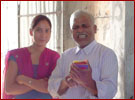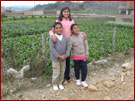
|
| Women in Nepal This data comes from www.himalayanlearning.org
THE PREGNANT WOMAN AND HER UNBORN CHILD The condition and treatment of a pregnant woman influence the survival of her unborn child. Although girls in Nepal are not legally entitled to marry before the age of 18 years, many are married by the age of 14 or 15 years. The median age at first marriage is 16.6 years . Early marriage is most common in rural areas and in the terai. Young women usually start to bear children soon after they are married; over 40 per cent of married women aged 19 years are either already mothers or are pregnant with their first child. This means that some mothers are barely more than children themselves and have yet to reach full physical maturity. In addition, many women are smaller than they should be, because they suffered from malnutrition during their own childhood. These conditions are known to increase the risk of complications during delivery, and can result in the deaths of both mothers and children. For older women, repeated pregnancies and closely-spaced births exhaust the body’s reserves and increase the likelihood of low- birth-weight babies. The current fertility rate for Nepali women aged 15–49 years is 4.1 . The nutritional status of women is generally poor, with a widespread lack of sufficient protein, vitamin A, iron and iodine in the diets of rural women. Furthermore, pregnant women are generally not acknowledged to have special dietary needs. Anaemia—low iron content in the blood—contributes to the high rates of maternal mortality seen in Nepal. Over three-quarters of pregnant women are anaemic . Only a quarter of women receive some iron–folate supplementation during pregnancy, and extremely few take a complete course . The health status of mothers can also affect the outcome of their pregnancies. Sexually transmitted infections and HIV/AIDS are becoming increasingly common in pregnant Nepali women. Malaria is endemic to Nepal; however only in limited areas. The material for this page is from www.un.org.np/reports/UNICEF/2006/situation-analysis/conver-page.pdf
|




